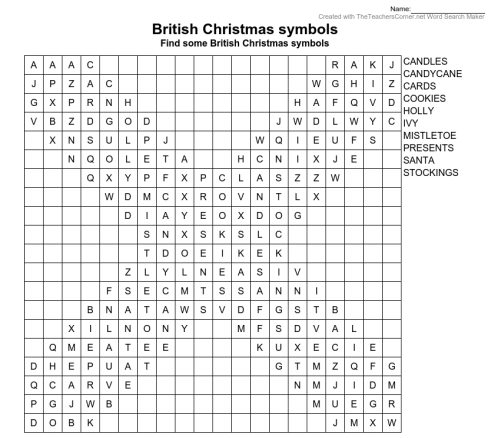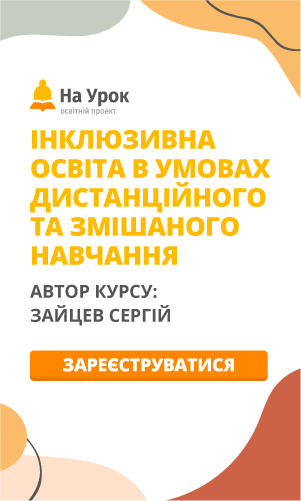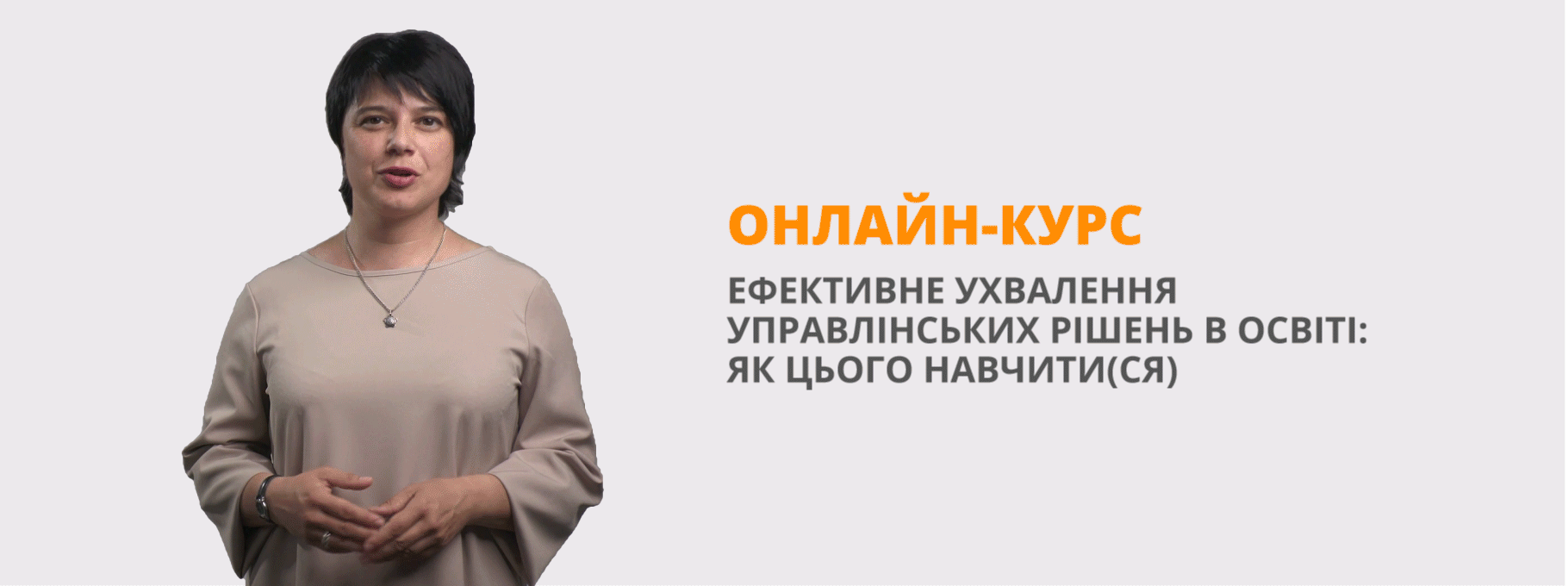X-MAS vibes! (цікаве різдвяне змагання)
X-MAS VIBES!
Ю.В. Бутенко, гімназія №107 «Введенська», м. Київ
AIMS: revise British Christmas symbols and 12 Ukrainian Christmas dishes, find the facts about "Carol of the Bells" and "Shchedryk", cooperate with classmates; develop grammar, communicative and listening skills, train attention and memory, respect traditions of Ukraine and Great Britain.
EQUIPMENT: Christmas posters on the walls, presentation in Power Point, colourful pencils, blanks with tasks, mp3/ video of "Carol of the Bells" and "Shchedryk", vyshyvanka for singers, presents from Secret Santa, cupcakes and juice.
PROCEDURE
Teacher: Good morning, dear students! The Spirit of Christmas is in the air. And today we’re having a lesson which is called "X-mas vibes!"
Christmas is celebrated on December, 25 in Great Britain. Let’s revise its symbols using Word Search. You’ve got the blanks on your desks. The task is in X-shape. Guess, why? (Christmas = X-mas).
Word Search
British Christmas symbols
- Work in pairs as you sit. Some 10 symbols of British Christmas are written on the sheets of paper. Use colourful pencils and mark these 10 words.
*For making Word Search you can use https://worksheets.theteacherscorner.net
Check the answers looking at the presentation

- Read and write 10 symbols next to their definitions.
|
VOCABULARY prickly leaves – колючі листочки crucified Christ – розп’ятий Христос frankincense – ладан myrrh – смирнa, мірра *work with the words using a slide in presentation |
- This caramel is white with red stripes and flavored with peppermint. Its "J" shape means Jesus. _______________
- It was created and sent in 1843 by John Calcott Horsley. Nowadays sending these things to relatives and friends is a good Christmas tradition. _______________
- Prickly leaves of this plant symbolize a crown and thorns of crucified Christ. Berries mean His blood. _______________
- This green plant needs something to wave around. It reminds us that a person needs Lord to get support and strength. _______________
- They say that this plant has mystery powers and brings luck. Kissing under hanging plants is one of Christmas traditions. _______________
- Giving and receiving them remind us about wise men who brought frankincense, gold and myrrh for newborn Jesus. _______________
- These three violet things mean liturgical colour of Advent. The pink one symbolizes Advent. The fifth one can be white or red and it symbolizes Light of the World in Christmas wreaths. _______________
- This old man in red clothes with a long white beard lives in the North Pole. He travels through the sky with reindeer team and brings presents for children. _______________
- People put these things above the fireplace and wait for presents. _______________
- Children leave this food next to the fireplace in order to treat Santa Claus. _______________
KEY: 1. Candy cane; 2. Cards; 3. Holly; 4. Ivy; 5. Mistletoe; 6. Presents; 7. Candles; 8. Santa; 9. Stockings; 10. Cookies.
Teacher: Ukrainians celebrate Christmas on January, 6. It’s important to have 12 dishes which are also called a Rich Dinner (Bahata Vecheria). And now there is…
Running Dictation
12 Ukrainian Dishes for Christmas Eve
- Make groups of 5.
- Decide who are "runners" and who are "writers" in each group. (At a later stage you could swap tasks).
- The text about 12 Ukrainian Christmas dishes is the same for each group. Copies are printed out and stuck on the walls, away from the desks.
- "Runners" run to the text, read, remember as much as they can and then they return to dictate the text to "writers". Then they run again.
REMEMBER!
- Don’t use your phone cameras to help you "remember" the text.
- "Runners", don’t write – dictate, spell the words.
- "Writers", don’t go to have a look at the text and don’t ask "runners" to bring it to you.
BE ATTENTIVE!
There are 12 mistakes in the text. "Runners", dictate the sentences as they are written. When your group is ready with the text, together you will find and correct 12 spelling and grammar mistakes.
12 Ukrainian Dishes for Christmas Eve
The evening before Christmas is the last evening of the lean. People should not eat anything until the first star appear in the sky, marking the birth of Jesus Christ. On the feast table Ukrainians put 12 dishes which symbolizes the 12 apostles. Kutia is one of the main dishes, cooked of wheat, barley or rice and seasoned with grated poppy seeds, nuts and honey. Uzvar is compote of dried fruit. Vinaigrette is cooked from boiled potatos, beets, carrotes and beans. Varenyky for Christmas dinner is cooked from dough and stuffed with chopped vegetables, mushrooms, fruits, cottage cheese or berrys. Cabbage soup also takes an important place on the Christmas table. In Ukrainian culture pickles like cucumbers, tomatoes, mushroomes, zucchini, sweet pepper, garlic and corn are popular. Appls for Christmas are baked in the oven with honey, cottage cheese and cinnamon. Borshch have more than 20 ingredients and is served with bread or patties. Patties can also be a great addition to tea for dessert. Buckwheat in Ukraine is consider to be one of the main dishes at the Christmas table. Stuffed cabbage rolls or golubtsy are wrap in boiled cabbage leaves. The colourful vegetable stew can be serve as a snack or as a side dish.
KEY: The evening before Christmas is the last evening of the lean. People should not eat anything until the first star appears in the sky, marking the birth of Jesus Christ. On the feast table Ukrainians put 12 dishes which symbolize the 12 apostles. Kutia is one of the main dishes, cooked of wheat, barley or rice and seasoned with grated poppy seeds, nuts and honey. Uzvar is compote of dried fruit. Vinaigrette is cooked from boiled potatoes, beets, carrots and beans. Varenyky for Christmas dinner are cooked from dough and stuffed with chopped vegetables, mushrooms, fruits, cottage cheese or berries. Cabbage soup also takes an important place on the Christmas table. In Ukrainian culture pickles like cucumbers, tomatoes, mushrooms, zucchini, sweet pepper, garlic and corn are popular. Apples for Christmas are baked in the oven with honey, cottage cheese and cinnamon. Borshch has more than 20 ingredients and is served with bread or patties. Patties can also be a great addition to tea for dessert. Buckwheat in Ukraine is considered to be one of the main dishes at the Christmas table. Stuffed cabbage rolls or golubtsy are wrapped in boiled cabbage leaves. The colourful vegetable stew can be served as a snack or as a side dish.
Teacher: The tradition of caroling is popular both in Great Britain and Ukraine. "Shchedryk" is the most famous Christmas Ukrainian melody in the world. "Carol of the Bells" and "Shchedryk" are the same carol, aren’t they? (melody is the same, lyrics are different) And now we’re going to work with them.
"Carol of the Bells" / "Shchedryk"
- 1. Exchange your sits, please (change the rows in order to make new pairs)
2. Read the text. Fill in the gaps using the verbs in the box. Put them in Past Simple Passive.
|
base compose perform accompany present take |
"Shchedryk" is the most popular Christmas Ukrainian melody in the world. It 1) _____________ by Ukrainian composer and music teacher, Mykola Dmytrovych Leontovych, in 1916. The title of the song in English means "the little swallow". It 2) _____________ first in Ukraine on the night of January 13, 1916.
The idea of lyrics 3) _____________ by Mykola Leontovych from a folk song. The carol begins with the phrase "the swallow’s flown". Is it possible in winter? We can explain it using the fact of New Year celebrations in early spring when birds were coming back from warm countries. There is information that "Shchedryk" 4) _____________ on the Slavonic legend about praising Jesus at night of His birth using every bell.
In the United States "Shchedryk" 5) _____________ first on October 5, 1921 at Carnegie Hall by the Alexander Koshetz’s Ukrainian National Chorus. Peter J. Wilhousky, a popular American composer and choral conductor, was a Ukrainian. When he heard "Shchedryk" he decided to create a new one. His lyrics in English 6) _____________ to the song's melody in 1936. Wilhousky copyrighted the new lyrics and got the song what we now know as "Carol of the Bells".
KEY: "Shchedryk" is the most popular Christmas Ukrainian melody in the world. It 1) was composed by Ukrainian composer and music teacher, Mykola Dmytrovych Leontovych, in 1916. The title of the song in English means "the little swallow". It 2) was first performed/ presented in Ukraine on the night of January 13, 1916.
The idea of lyrics 3) was taken by Mykola Leontovych from a folk song. The carol begins with the phrase "the swallow’s flown". Is it possible in winter? We can explain it using the fact of New Year celebrations in early spring when birds were coming back from warm countries. There is information that "Shchedryk" 4) was based on the Slavonic legend about praising Jesus at night of His birth using every bell.
In the United States "Shchedryk" 5) was first performed/presented on October 5, 1921 at Carnegie Hall by the Alexander Koshetz’s Ukrainian National Chorus. Peter J. Wilhousky, a popular American composer and choral conductor, was a Ukrainian. When he heard "Shchedryk" he decided to create a new one. His lyrics in English 6) were accompanied to the song's melody in 1936. Wilhousky copyrighted the new lyrics and got the song what we now know as "Carol of the Bells".
- Take pieces of paper out the envelopes. These are lyrics of "Carol of the Bells". Listen to mp3 (or video) and make up the lyrics.
*use the link with "Carol of the Bells"; the carol here is playing 3 times. https://www.youtube.com/watch?v=J0uGnm3dGvc
*look at the translation of some words using presentation.
*sing altogether.
Carol of the Bells
Hark how the bells,
sweet silver bells,
all seem to say,
throw cares away
Christmas is here,
bringing good cheer,
to young and old,
meek and the bold,
Ding dong ding dong
that is their song
with joyful ring
all caroling
One seems to hear
words of good cheer
from everywhere
filling the air
Oh how they pound,
raising the sound,
o’er hill and dale,
telling their tale,
Gaily they ring
while people sing
songs of good cheer,
Christmas is here,
Merry, merry, merry, merry Christmas,
Merry, merry, merry, merry Christmas,
On on they send,
on without end,
their joyful tone
to every home
Din don din… don!
- Ask some students to wear vyshyvanka and sing "Shchedryk". // watch video with Tina Karol in St. Sophia’s Cathedral singing "Shchedryk", for example.
Щедрик, щедрик, щедрівочка,
Прилетіла ластівочка,
Стала собі щебетати,
Господаря викликати:
«Вийди, вийди, господарю,
Подивися на кошару, -
Там овечки покотились,
А ягнички народились.
В тебе товар весь хороший,
Будеш мати мірку грошей,
Хоч не гроші, то полова,
В тебе жінка чорноброва.»
Щедрик, щедрик, щедрівочка,
Прилетіла ластівочка.
Teacher: Two weeks ago we played "Secret Santa". And now get ready with your presents, please.
Secret Santa
- Print students’ names on separate sheets of paper.
- Put the names into a "magic bag/box".
- Ask your students to choose papers with the names from the bag/box. One student = one name.
- Discuss the price for presents. They mustn’t be expensive.
- The students mustn’t tell each other the names they’ve chosen. They’ll be Secret Santa for each other.
*учитель вмикає різдвяні мелодії й учні дарують один одному подарунки.
Солодкий стіл.
Фото на пам'ять.
Teacher: Dear students! Thank you for your working today. Merry Christmas to you!


про публікацію авторської розробки
Додати розробку
